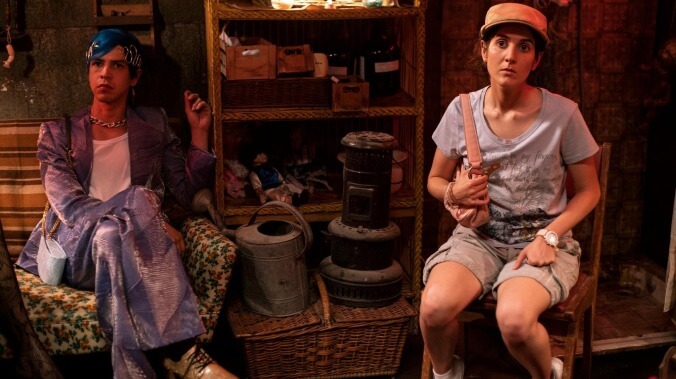Los Espookys lets us back into its weird little world
In its stellar second season, HBO’s singular Spanish-language comedy becomes more comfortable in its skin

Quick. Name another show besides Los Espookys that would unleash a character, a dozen minutes into its second season, like so: “Oliver Twix doesn’t have to bury the bodies where they belong,” a young, pink-haired, flamboyant undertaker (Sebastián Ayala) goes off, all how-dare-you attitude while sitting in a dim graveyard shack that’s kind of like a DIY space meets a punk’s fashion-school dorm room meets a dash of Pee-wee’s Playhouse. (He explains that his name is “like the movie,” giving a self-satisfied smirk.) “So now I have to deal with all these people who come here, crying, saying, ‘Where’s my uncle? Where’s my mom? Where’s my grandma? Where are the bodies?’” If you can’t name one—and we certainly can’t—then, huzzah you … won? Or lost? Or something? And if you can, please let us know what you think of said show in the comments.
It’s been three years since the first season of this (mostly) Spanish-language HBO comedy aired—how is it that this series dropped before the pandemic, again?—and it’s pretty refreshing to dip back into its decidedly weird, singular waters, where a person like the one above doesn’t throw our quartet of horror side hustlers. In fact, Oliver Twix is completely everyday to them. What does throw them is anything milquetoast or square, like, this season, a group of prep bros with sweaters tied around their shoulders sipping drinks, or a perky, overprepared young woman who makes a slideshow presentation to get a gig with the group, complementing them on being so “arty” and “weird” and “dark,” which makes them scoff and roll their eyes.
About that gig and this show: If you haven’t seen season one, do it. (It’s only six episodes, as is this season, and each one is a brisk, fun 25 minutes or so.) But basically, Los Espookys—created by Fred Armisen, former SNL writer Julio Torres, and New York standup Ana Fabrega—is kind of like an indie Ghostbusters but in reverse, following a group of friends who are hired to stage elaborate, albeit very DIY, hauntings and other out-there experiences. As an example, that undertaker with the problem of those pesky family members being mad that he buried their loved ones in the wrong plots? With the help of a smoke machine, a script, some unconvincing acting, homemade ghost costumes, and a makeshift pulley system, Los Espookys—that’s what they call themselves—assuage the bereaved. (There is also a great job in which an elementary school teacher, in order to instill obedience in her classroom, hires the gang to create a monster that the kids fall in love with, only to have that monster die in front of them when he defies authority.)
And about that gang: This season, the blue-haired Andrés (Torres, fantastic) is moaning that he has to have a 45-minute-per-day gig modeling staircases in a lavish sequined suit. (If you need a quick description, know that he breaks up with a boyfriend by saying, “You seem very sweet but all I want is someone with lots of money who puts me in a gold cage.”) His understanding friend Renaldo (Bernardo Velasco) is a horror obsessive who keeps seeing the ghost of an impaled beauty queen. Úrsula (Cassandra Ciangherotti, magnetic) is the kind of person easily lured into a trap with a flyer promoting a “free radical queer vegan tarot book swap” who’s hoping to oust the fictional country’s misogynistic President. And her cousin Tati (Fabrega, very funny) is a childlike goofball who is married to a rich gay man who happens to be Andrés’ ex. Oh, and this time around, Renaldo’s uncle Tico (Armisen), whose job as a valet has become moot thanks to self-parking cars, is crashing at his house and becomes a member of the gang, too. Meanwhile, Tico’s social-media-addicted nightmare of a daughter, played by the scene-stealing River L. Ramirez, doesn’t. (This season also promises appearances from Isabella Rossellini, as herself; Kim Petras, as the Secretary of State; and Roma’s Yalitza Aparicio, as Andrés’s guide/the moon.)
This latest batch also boasts some assured direction from Sebastián Silva, who was behind the funny, wonderful, Michael-Cera-as-a-gringo road movie Crystal Fairy & The Magical Cactus. (Fabrega, who co-wrote each installment with Torres, directs the final two, which we unfortunately weren’t able to watch in time for this review.) What worked last time—the comic chemistry between the main quartet, the cool synthy original music and choice soundtrack picks, the color scheme and dramatic lighting, the camp and absurdity, the aesthetic and wit—works again this time, only with maybe a bit more punch and sharpness. And if you don’t find a scene in which Fabrega’s Tati, looking for inspiration to write the next great novel and walking by scenes like a person being shoved into a trunk, only to stumble upon an audiobook of Don Quixote and decide that her opus will be its transcription hilarious, then we don’t know what to tell you. Which is all to say to the rest of you: Please, see this show.